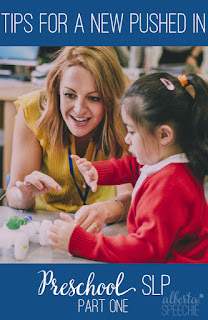This is the time of year where many Speech-Language Pathologists (SLPs) start to change jobs. As a result, SLPs are soliciting advice about how to be successful in their new positions. Here are my tips for an SLP who is new to pushed in Preschool Special Education preschool (SPED) classrooms.
1. Establish a good working relationship with the classroom staff. When classroom teams work well together, it goes really well, but when there are issues between team members, it can make for a very loooong and challenging year. This is especially true with pushed in therapy because you are going to be spending more time with the other classroom staff than if you are doing pull out therapy. These can be long conversations, but they are essential to have before everyone is feeling frustrated and/or stressed. At the beginning of the year, here are some critical questions to ask or topics to discuss:
- What are the views on dealing with behaviours?
- What is talking with parents in the classroom going to look like?
- What is your general philosophy towards therapy and what is their experience in the past?
- How do you like staff to share information with you and vice versa?
- What are your duties going to be in the classroom?
- If you are not in the classroom the whole time, when will you be there and what will that look like.
2. Establish a routine. Whether you are working with the rest of the classroom staff to establish a routine for the whole class or not, when you are in the classroom, you need to develop a routine. If you are leading circle or part of circle, make sure that you have a routine. If you are doing adult-directed activities, make sure that you have a routine. This will allow the children to be able to follow the activity and to know when it is over. This will make your time with the students more productive and it will reduce any anxiety a preschooler may be feeling.
3. Make visuals your new best friend. You all know how important visuals are. While visuals are important in the older grades, they are imperative in a preschool classroom. For many students, this is their first time away from home which is scary. On top of a language delay, they may not speak English at home or speak it sparingly. This makes it even more imperative to have pictures ready to start treating the language delays and introduce students to English. Visuals will help with children's fears (they will learn faster what to expect), increase familiarity with routines, and help students to learn how to be in a group. The faster you can make them used to establish the routine and the classroom expectations, the faster and better the classroom will run. One of the first steps is to have your visuals ready.
Make sure you have a variety of visuals. It is important to have visuals prepared for all transitions that occur in the classroom. First/then boards, choice boards, schedules, self-help sequences are just a few types of visuals I make sure that I have ready for the beginning of the year. I typically have smaller ones to show individual students and larger visuals to show the whole group. It's a lot I know, but it is better to be over prepared than under prepared.
4. Make sure that you have a general AAC strategy ready for the classroom. Over the years, the number of children who start preschool not talking in my school has increased dramatically. These students may not have any AAC in place. If you are lucky, they may have been working on using PECS. My philosophy is that PECS is not enough to teach children to communicate. Having a general strategy for the whole class is very valuable to help introduce AAC to the children and their parents. It also starts the expectation of using aided language strategies on the first day which establishes good habits for the staff and the students.
5. Become familiar with the toys/centres in the classroom. I work at a play-based centre and so I tend to use the equipment in the classroom especially for the young ones who have short attention spans and still learning to sit for adult-directed activities. What figurines do they have? Do they have a water or sand table? Do they have cars? Think about what goals/vocabulary you can use in the different areas or with the different toys. Especially at the start of the year, you will have better engagement and longer direct therapy time with preschoolers who are having fun at a centre than trying to have the students run on your agenda.
These are just five times, to make your preschool experience a positive one. To see part two of this topic, go here.
These are just five times, to make your preschool experience a positive one. To see part two of this topic, go here.


No comments:
Post a Comment